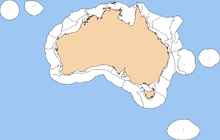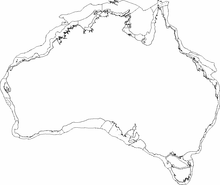Integrated Marine and Coastal Regionalisation of Australia
The Integrated Marine and Coastal Regionalisation of Australia (IMCRA), formerly the Interim Marine and Coastal Regionalisation for Australia, is a biogeographic regionalisation of the oceanic waters of Australia's Exclusive Economic Zone (EEZ). As of 2008, the most recent version is IMCRA Version 4.0.[1][2]
IMCRA actually defines two bioregionalisations: a benthic bioregionalisation, based on biogeography of fish together with geophysical data; and a pelagic bioregionalisation, base on oceanographic characteristics.[2]
The benthic bioregionalisation incorporates three separate regionalisations:[2]
- A regionalisation of the EEZ into provincial bioregions, based on the biogeography of bottom dwelling fishes. In IMCRA 4.0, 41 provincial bioregions, consisting of 24 provinces and 17 transitions.
- A regionalisation of the continental shelf into meso-scale regions based on biological and physical characters, and the distance from the coast. In IMCRA 4.0 there are 60 meso-scale regions.
- A regionalisation of the EEZ into 14 geomorphic units, formed by grouping the 1,134 geomorphic units defined by Geoscience Australia.
The pelagic bioregionalisation divides the continental shelf into four provincial bioregions based on pelagic fish species biodiversity and richness. Offshore waters are divided into three-dimensional water masses, taking into account water properties, circulation patterns and energetics.[2]
List of provincial bioregions
This is a list of IMCRA 4.0 provincial bioregions:[3]
| Bioregion | Information |
|---|---|
| Bass Strait Shelf Province | |
| Cape Province | |
| Central Eastern Shelf Province | |
| Central Eastern Shelf Transition | |
| Central Eastern Province | |
| Central Eastern Transition | |
| Central Western Shelf Province | |
| Central Western Shelf Transition | |
| Central Western Province | |
| Central Western Transition | |
| Christmas Island Province | |
| Cocos (Keeling) Island Province | |
| Great Australian Bight Shelf Transition | |
| Kenn Province | |
| Kenn Transition | |
| Lord Howe Province | |
| Macquarie Island Province | |
| Norfolk Island Province | |
| Northeast Shelf Province | |
| Northeast Shelf Transition | |
| Northeast Province | |
| Northeast Transition | |
| Northern Shelf Province | |
| Northwest Province | |
| Northwest Shelf Province | |
| Northwest Shelf Transition | |
| Northwest Transition | |
| Southeast Shelf Transition | |
| Southeast Transition | |
| Southern Province | |
| Southwest Shelf Province | |
| Southwest Shelf Transition | This bioregion was referred to as the South Western Biotone in Integrated Marine and Coastal Regionalisation of Australia (IMCRA) Version 3.3,[1] and as the Southwest IMCRA Transition in the National Marine Bioregionalisation of Australia. Both Southwest IMCRA Transition and Southwest Shelf Transition are used in IMCRA Version 4.0.[2][3] The region extends along the continental shelf roughly from Perth to Geraldton, Western Australia, and has an area of about 27,000 square kilometres. Depth ranges from zero to nearly 300 metres, with a mean depth of 41 metres. Geomorphically the seabed is almost entirely shelf, but there is a small area of scarp at the northern limits.[4] The province contains two meso-scale bioregions: Abrolhos Islands, consisting of the marine environment immediately sounding the Houtman Abrolhos, and Central West Coast, comprising the remaining area.[2] Biologically, it is a highly complex transition zone, with many species from other provinces reaching a limit of their range in this bioregion. In particular, it represents a northern limit of a number of warm temperate species, and the southern limit of a number of sub-tropical and tropical species. |
| Southwest Transition | |
| Spencer Gulf Shelf Province | |
| Tasmania Province | |
| Tasmanian Shelf Province | |
| Timor Province | |
| Timor Transition | |
| West Tasmania Transition | |
| Western Bass Strait Shelf Transition |

List of Benthic meso-scale regions
|
|
|

List of Benthic geomorphic units
|
|
|
See also
External links
References
- ↑ 1.0 1.1 IMCRA Technical Group. "Interim Marine and Coastal Regionalisation for Australia: an ecosystem-based classification for marine and coastal environments". Environment Australia, Department of the Environment, Australian Government. Retrieved 2013-12-23.
- ↑ 2.0 2.1 2.2 2.3 2.4 2.5 "A guide to the Integrated Marine and Coastal Biogeographic Regionalisation of Australia: IMCRA Version 4.0: June 2006". Department of the Environment, Australian Government. Retrieved 2013-12-23.
- ↑ 3.0 3.1 IMCRA 4.0 data
- ↑ "2005 National Marine Bioregionalisation of Australia". Geoscience Australia. Retrieved 2008-02-26.